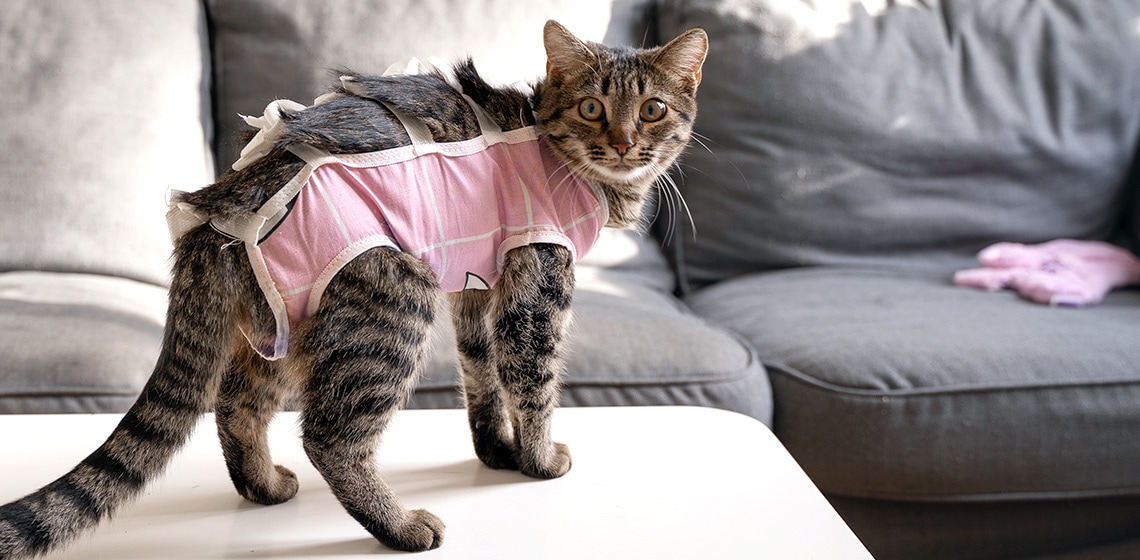Kittens are playful, curious, naughty balls of fluff. Somehow, they get away with ripping our curtains, clawing our carpet, and generally making mischief, but we still think they’re cute! But what about when they grow a little and come into season? A cat in season can be irritating at best but also downright alarming to the untrained eye!
Constant yowling at the door, displaying their bits to you and throwing themselves to the ground, and writhing as if in pain – their behavior is quite impossible to ignore. So, is neutering the answer? And how much does it cost to spay your cat?
Table of Contents
What does spaying a cat involve?
A cat spay is a surgery to remove the uterus and both ovaries. It is performed under a general anesthetic and can either be approached through the left flank or the midline. When the ovaries and uterus are removed, the blood vessels are tied, and the muscle and skin stitched up. The stitches are sometimes dissolvable or may need removing at around 10 to 14 days.
Your kitty might need a cone collar to stop them from licking or chewing at their stitches, and they’ll usually need to stay indoors until they are healed. Your cat will need anti-inflammatory medication for a few days to ease the pain and help them recover.
A cat spay is a surgery to remove the uterus and both ovaries.
What are the benefits of spaying your cat?
No more kittens!
If a female cat isn’t spayed, she will continue to come into season regularly until she falls pregnant. Cats are seasonally polyestrous, meaning that they begin coming into season in Spring when the days are getting longer and continue to have seasons throughout the summer until mid-Fall. Once they give birth to a litter of kittens, they begin cycling again and can even become pregnant while nursing a young brood. So, one of the main benefits of spaying your cat is to prevent unwanted pregnancy and reduce the number of kittens in rescue centers.
As if this weren’t reason enough, it’s also worth remembering that young cats can become pregnant when they are merely kittens themselves. This is dangerous, and the birthing process can cause injury or even death to the mother, while the kittens may be rejected.
Better health
Cats are proven to live longer if they are neutered. This will partly be due to a lower risk of contracting diseases spread through fighting or breeding. Female cats who are spayed are also protected from getting a severe womb infection, called a pyometra, and are less at risk of breast cancer.
Reduced behavior issues
Neutering of both female and male cats can reduce behaviors like spraying, fighting, and other forms of territory marking. However, it’s best done when they’re young, or this behavior could become a habit rather than being fueled by hormones. If you’ve got a problem with your cat peeing in inappropriate places, you can check out this blog post for more information or this post for tips on cleaning up.
And more!
You can find more benefits of neutering your cats here.
Cats are proven to live longer if they are neutered.
Are there any risks?
A cat spay is a routine surgical procedure performed frequently by your veterinarian. It is considered very safe, and your feline friend should be back to normal within 7-10 days. Of course, even in humans, there is a small anesthetic risk, and this is true of cats also. However, an anesthetic reaction is incredibly rare.
One more common complication is an infection, usually caused by your cunning kitty sneaking a lick of their wound. However, a well-fitting cone collar and a course of antibiotics manage most of these cases.
Occasionally, cats can continue to show signs of a season even though they have been spayed. This might mean they have some ectopic ovarian tissue elsewhere in their body, and if your vet suspects this, they can do a blood test to find out.
A cat spay is a routine, safe surgical procedure performed frequently by your veterinarian.
What is the best age to spay a cat?
The best time to spay your cat is around 4-6 months of age before they come into season for the first time. This means that your cat will have less time to develop territorial behavior issues, and they will be protected from pyometra and breast cancer. If your cat comes into season or even gets pregnant before she is spayed, it can become challenging to find the right time to spay her when she is not pregnant or calling. Sadly, many female cats and their owners get stuck in a vicious cycle of repeated pregnancies.
The best time to spay your cat is around 4-6 months of age before they come into season for the first time.
How much does a cat spay cost?
The cost of a cat spay will vary depending on many factors. Firstly, where you live will impact the cost, and there will be variations between veterinary clinics. The price will also vary depending on whether the surgeon intends to use the midline or flank approach. A good ballpark figure for a cat spay procedure in a private veterinary clinic is $200-500. However, if you enquire with a charity or not-for-profit clinic, you’ll probably be able to find it cheaper.
So, is it worth it to spay a cat?
The cost of a cat spay can seem worryingly expensive, and it might be tempting not to bother. However, it’s crucial to remember that spaying your cat will benefit their health and make them a much better housemate!
FAQ
The term for neutering a female cat is called ‘spaying’ rather than spraying. The cost will vary depending on many factors, including where you live and what type of veterinary clinic you use. Private veterinary clinics charge between $200 and $500, whereas not-for-profit clinics may charge in the region of $50 to $100.
Veterinary fees can seem expensive, but it’s important to consider what you’re getting for your money. When your cat is spayed, they receive care from a veterinary technician. The vet tech closely monitors their anesthetic and keeps them safe and comfortable while the veterinarian performs abdominal surgery. The monitoring equipment, anesthetic drugs, pain relief, and other medications are also included in the price you pay.

Dr. Hannah Godfrey MRCVS graduated from the Royal Veterinary College in 2011. Although she initially worked in mixed practice treating all species, she found a love for small animal work and has worked exclusively with dogs and cats since 2014. She lives in Wales with her partner, son, and two cats (named Poppy and Ashton Kutcher), and writes comedy fiction in her spare time.








